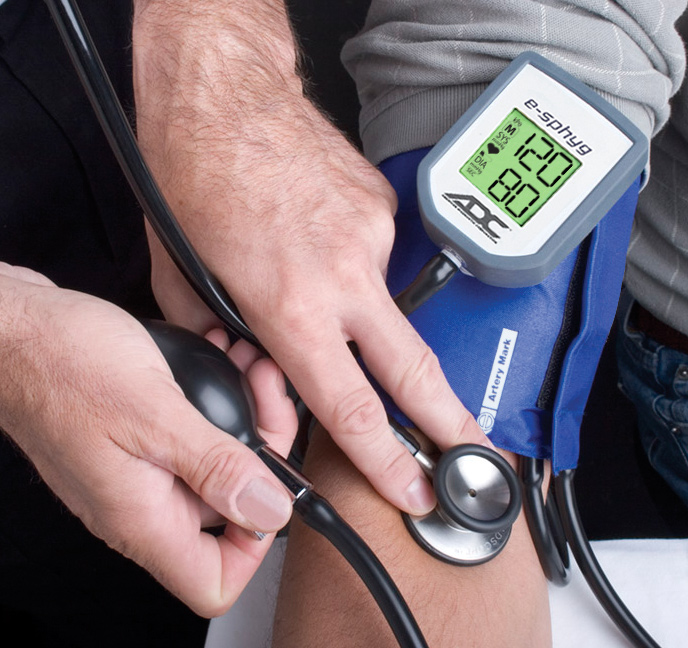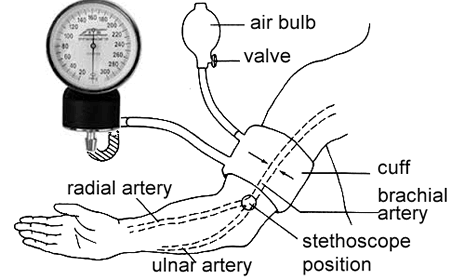Get comfortable opening and closing the pressure valve so you can hold the bulb and operate the valve easily with one. Your patient has a blood pressure of 142100.
Vital Signs Client Care Nursing Part 5
Interval between repeated measurements.

. As you release air from the cuff you listen for the sound of the blood as it starts to flow through the artery again. Note when you no longer hear the beating sounds. A blood pressure cuff is composed of a cuff or sleeve a meter an inflation bulb and hoses that connect everything together.
Stethoscope placement patient positioning and familiarity with heart lung and other body sounds are the keys to ensuring that you are performing auscultation properly. Ad In-stock ready to ship. The circumference of the diaphragm must be just underneath the cuff and be positioned over the artery.
Let the pressure fall 2 millimeters or lines on the dial per second while listening for your heart sounds. It has been recommended that the stethoscope should be placed gently over the brachial artery at the point of maximal pulsation and held firmly and evenly but without excessive pressure16in clinical practice the stethoscope is sometimes placed under the cuff but traditionally and more usually outside the cuff over the brachial artery in the. Expose the arm and ensure that clothes do not hinder the placement of the cuff or stethoscope.
Blood pressure measur AND talk OR talks OR talking 28. During the blood pressure measurement the doctor will place the stethoscope on the brachial artery which is in your arm to listen to your blood flow. The standard for blood pressure cuff placement is the upper arm using a cuff on bare skin with a stethoscope placed at the elbow fold over the brachial artery.
The brachial pulse is palpated just above the angle of the elbow the antecubital fossa. The diaphragm must be placed flat against the skin on the arm of the patient. Rest quietly and wait about one to two minutes before taking another.
Blood pressure AND stethoscope AND placement OR location 4. The reading on the gauge when blood flow is first heard is the systolic pressure. Partially tuck the bell of the stethoscope under the blood pressure.
In clinical practice it is sometimes placed under the cuff but more usually outside the cuff on the antecubital fossa. Your sternum is about where your clavicle bones meet in the middle of your upper chest. With your participant comfortably seated and arm resting on lab table wrap cuff around the upper arm brachium about.
Blood pressure BP measurement deflation of the cuff at a rate faster than 2-3 mmHgsec and placement of the stethoscopes diaphragm beneath the cuff affect blood pressure measurement. The blood pressure cuff is placed on the subjects right arm allowing 1 inch between the bottom of the cuff and the crease of the elbow. The correct positioning of the cuff as shown by the Artery Mark and stethoscope for optimal measurement.
The cuff should be placed snugly around the upper arm and the bladder of the cuff should cover at least 80 of the arms circumference. Position the chestpiece in the antecubital space below the cuff distal to the brachium. Hear clearly diagnose confidently and give your patients the best care possible.
Locate the popliteal artery for thigh BP or the dorsalis pedis or posterior tibial artery for calf BP and place the diaphragm of the stethoscope over it below the lower edge of the cuff. Listen to the blood flow. Blaha MD MPH director of clinical research at the Johns Hopkins Ciccarone Center for the Prevention of Heart Disease in Baltimore.
Use code LUNGS for 50 savings off professional stethoscopes. You should become familiar with the anatomy of the heart lungs and abdomen so you can better choose the ideal location for your stethoscope. Place the inflatable blood pressure cuff securely on the upper arm.
Once you understand why you need a stethoscope when taking blood pressure it is also essential to be familiar with how it should be placed. Position the bell of the stethoscope over where you felt the pulsation of your brachial artery. The patient should be sitting with.
However there is little scientific evidence to quantify the BP difference between the BP measurements taken with. Placement of the stethoscope on the left facing the patient inter-costal space between rib 2 and 3 will allow for the sound produced by the --------------------valve to be heard. The lower end of the blood pressure cuff is placed 2-3 cm above the antecubital fossa which should be at approximately the same vertical height as the heart while allowing room for the stethoscope.
The reading when blood flow can no longer be heard is the diastolic pressure. A blood pressure cuff is a piece of medical equipment used to measure an individuals blood pressure. Do not place chestpiece underneath the cuff as this impedes accurate measurement.
Regardless of the type of monitor when the cuff is placed on your upper arm it has to be at heart level when measuring your blood pressure. This study used repeated measures design with 116 nursing students. Blood pressure AND diaphragm AND bell.
This is your diastolic pressure. Adding a leg blood pressure reading into the mix can offer you a much broader handle on the true health of your arteries. You place the stethoscope on the skin over the artery.
It contains several individual parts and may need to be assembled prior to use. This will measure your blood pressure together with the inflatable cuff. 6 Do not allow the chest piece to touch the cuff or clothing.
One group member puts on a stethoscope with the earpieces on the headpiece angled forward. Blood pressure AND deflat rate. This is known as--------- 2.
When measuring blood pressure BP using the auscultation method a stethoscope is commonly used. The device must be close enough for you to read the display. We offer sphygmomanometers constructed with precision and quality materials to.
A built-in stethoscope bell be sure to position the cuff so the bell is over the artery. The perfomance of the device depends greatly on calibration Tolonen et al 2015. Note the reading when you first hear a heartbeat.
This is your systolic pressure. Muscle contraction raises blood pressure Frese et al 2011 so make sure the arm is supported. Using the bell of the stethoscope may cause an inaccurate measurement.
Specifically the middle of the cuff should be at the height of your right atrium the midpoint of your sternum r. Blood pressure can be measured in the arm leg or even the foot says Michael J.
Stethoscope Bell And Sphygmomanometer Cuff Placement

How To Take Blood Pressure American Diagnostic Corporation

How To Appropriately Measure Blood Pressure In A Practice Setting Youtube

Ppt This Demonstrates The Location Of The Cuff And Placement Of The Stethoscope For Taking Blood Pressure Powerpoint Presentation Id 632605

Blood Pressure 2 Procedures For Measuring Blood Pressure Nursing Times
Chapter 4 Cardiovascular Experiments Anatomy And Physiology 2 Lab Manual


0 komentar
Posting Komentar